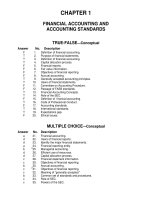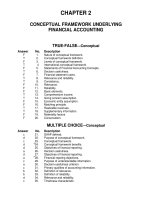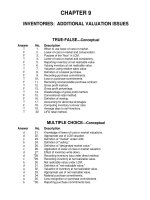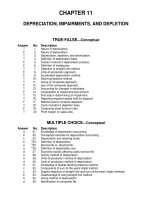Intermediate accounting 16e by kieso slide ch14
Bạn đang xem bản rút gọn của tài liệu. Xem và tải ngay bản đầy đủ của tài liệu tại đây (2.21 MB, 103 trang )
14-1
PREVIEW OF CHAPTER 14
14-2
Intermediate Accounting
16th Edition
Kieso ● Weygandt ● Warfield
14
Long-Term Liabilities
LEARNING OBJECTIVES
After studying this chapter, you should be able to:
1 Describe the nature of bonds
and indicate the accounting for
bond issuances.
2 Describe the accounting for the
extinguishment of debt.
4 Describe the accounting for the
fair value option.
5 Indicate how to present and
analyze long-term debt.
3 Explain the accounting for longterm notes payable.
14-3
LO 1
BONDS PAYABLE
Long-term debt consists of probable future sacrifices of
economic benefits arising from present obligations that are
not payable within a year or the operating cycle of the
company, whichever is longer.
Examples:
►
Bonds payable
►
Pension liabilities
►
Long-term notes payable
►
Lease liabilities
►
Mortgages payable
Long-term debt has various
covenants or restrictions.
14-4
LO 1
BONDS PAYABLE
Issuing Bonds
Bond contract known as a bond indenture.
Represents a promise to pay:
1. sum of money at designated maturity date, plus
2. periodic interest at a specified rate on the maturity amount
(face value).
14-5
Paper certificate, typically a $1,000 face value.
Interest payments usually made semiannually.
Used when the amount of capital needed is too large for one
lender to supply.
LO 1
BONDS PAYABLE
Types of Bonds
Common types found in practice:
14-6
Secured and Unsecured (debenture) bonds.
Term, Serial, and Callable bonds.
Convertible, Commodity-Backed, Deep-Discount bonds.
Registered and Bearer (Coupon) bonds.
Income and Revenue bonds.
LO 1
Types of Bonds
Corporate bond listing.
Company
Name
Maturity
date
Price as a
% of par
Face and
maturity
value
14-7
Interest
rate based
on price
Interest rate
paid as a %
of par value
LO 1
Valuation and Accounting for Bonds
Payable
Issuance and marketing of bonds to the public:
14-8
Usually takes weeks or months.
Issuing company must
►
Arrange for underwriters.
►
Obtain SEC approval of the bond issue, undergo
audits, and issue a prospectus.
►
Have bond certificates printed.
LO 1
Valuation and Accounting for Bonds
Selling price of a bond issue is set by the
supply and demand of buyers and sellers,
relative risk,
market conditions, and
state of the economy.
Investment community values a bond at the present value of
its expected future cash flows, which consist of (1) interest
and (2) principal.
14-9
LO 1
Valuation and Accounting for Bonds
Interest Rate
Stated, coupon, or nominal rate = Rate written in the
terms of the bond indenture.
►
Bond issuer sets this rate.
►
Stated as a percentage of bond face value (par).
Market rate or effective yield = Rate that provides an
acceptable return commensurate with the issuer’s risk.
►
14-10
Rate of interest actually earned by the bondholders.
LO 1
Valuation and Accounting for Bonds
How do you calculate the amount of interest that is actually paid
to the bondholder each period?
(Stated Rate x Face Value of the Bond)
How do you calculate the amount of interest that is actually
recorded as interest expense by the issuer of the bonds?
(Market Rate x Carrying Value of the Bond)
14-11
LO 1
Valuation and Accounting for Bonds
Assume Stated Rate of 8%
14-12
Market Interest
Bonds Sold At
6%
Premium
8%
Par Value
10%
Discount
LO 1
Valuation and Accounting for Bonds
Illustration: ServiceMaster Company issues $100,000 in bonds,
due in five years with 9 percent interest payable annually at yearend. At the time of issue, the market rate for such bonds is 11
percent.
ILLUSTRATION 14-1
Time Diagram for Bond Cash Flows
14-13
LO 1
Valuation and Accounting for Bonds
ILLUSTRATION 14-1
ILLUSTRATION 14-2
Present Value Computation of Bond Selling at a Discount
14-14
LO 1
WHAT DO THE NUMBERS MEAN?
HOW’S
MY RATING?
WHAT’S YOUR
PRINCIPLE
Two major publication companies, Moody’s Investors Service and Standard &
Poor’s Corporation, issue quality ratings on every public debt issue. The table
to the right summarizes the ratings issued by Standard & Poor’s, along with
historical default rates on bonds with different ratings.
As expected, bonds receiving the highest quality rating of AAA have the lowest
historical default rates. Bonds rated below BBB, which are considered below
investment grade (“junk bonds”), experience default rates ranging from 20 to
50 percent. Debt ratings reflect credit quality. The market closely monitors
these ratings when determining the required yield and pricing of bonds at
issuance and in periods after issuance, especially if a bond’s rating is upgraded
or downgraded. Unfortunately, the median rating of companies assessed by
Standard & Poor’s has recently fallen from A to BBB.
14-15
(continued)
LO 1
WHAT DO THE NUMBERS MEAN?
HOW’S
MY RATING?
WHAT’S YOUR
PRINCIPLE
The BBB rating is the lowest possible “investment grade” or, to put it another
way, is just one notch above “junk” bond status. It should be noted that
investors who seek triple-A debt are running out of options. Standard & Poor’s
recently gave its top rating to just three U.S. industrial companies: ExxonMobil,
Johnson & Johnson, and Microsoft. Indeed, the overall decline in ratings can
be explained in part by the growing issuance of CCC-rated debt in a variety of
industry sectors, as shown in the chart to the right. Years of low interest rates
have encouraged some of the riskiest corporate borrowers to tap yield-hungry
investors to finance their growth, spurring issuance of debt that comes with
triple-C credit ratings. For investors willing to shoulder the burden of those
extra risks in exchange for heftier returns, CCC-rated bonds have been
alluring.
14-16
LO 1
Bonds Issued at Par on Interest Date
Illustration: Buchanan Company issues at par 10-year term
bonds with a par value of $800,000, dated January 1, 2017, and
bearing interest at an annual rate of 10 percent payable
semiannually on January 1 and July 1, it records the following
entry.
Journal entry on date of issue, Jan. 1, 2017.
Cash
Bonds Payable
14-17
800,000
800,000
LO 1
Bonds Issued at Par on Interest Date
Journal entry to record first semiannual interest payment on
July 1, 2017.
Interest Expense
40,000
Cash
40,000
($800,000 x .10 x ½)
Journal entry to accrue interest expense at Dec. 31, 2017.
Interest Expense
Interest Payable
14-18
40,000
40,000
LO 1
Bonds Issued at Discount on Interest Date
Illustration: If Buchanan Company issues $800,000 of bonds on
January 1, 2017, at 97, and bearing interest at an annual rate of
10 percent payable semiannually on January 1 and July 1, it
records the issuance as follows.
Cash ($800,000 x .97)
Discount on Bonds Payable
Bonds Payable
776,000
24,000
800,000
Note: Assuming the use of the straight-line method, $1,200 of the discount
is amortized to interest expense each period for 20 periods ($24,000 ÷ 20).
14-19
LO 1
Bonds Issued at Discount on Interest Date
Illustration: Buchanan records the first semiannual interest
payment and the bond discount on July 1, 2017, as follows.
Interest Expense
41,200
Discount on Bonds Payable
1,200
Cash
40,000
At Dec. 31, 2017, Buchanan makes the following adjusting entry.
Interest Expense
Discount on Bonds Payable
Interest Payable
14-20
41,200
1,200
40,000
LO 1
Bonds Issued at Premium on Interest Date
Illustration: If Buchanan Company issues $800,000 of bonds on
January 1, 2017, at 103, and bearing interest at an annual rate of
10 percent payable semiannually on January 1 and July 1, it
records the issuance as follows.
Cash ($800,000 x 1.03)
Premium on Bonds Payable
Bonds Payable
824,000
24,000
800,000
Note: With the bond premium of $24,000, Buchanan amortizes $1,200 to
interest expense each period for 20 periods ($24,000 ÷ 20).
14-21
LO 1
Bonds Issued at Premium on Interest Date
Illustration: Buchanan records the first semiannual interest
payment and the bond premium on July 1, 2017, as follows.
Interest Expense
Premium on Bonds Payable
38,800
1,200
Cash
40,000
At Dec. 31, 2017, Buchanan makes the following adjusting entry.
Interest Expense
Premium on Bonds Payable
Interest Payable
14-22
38,800
1,200
40,000
LO 1
Bonds Issued Between Interest Dates
When companies issue bonds on other than the interest
payment dates,
14-23
Buyers will pay the seller the interest accrued from the last
interest payment date to the date of issue.
On the next semiannual interest payment date,
purchasers will receive the full six months’ interest
payment.
LO 1
Bonds Issued Between Interest Dates
Illustration: On March 1, 2017, Taft Corporation issues 10-year
bonds, dated January 1, 2017, with a par value of $800,000.
These bonds have an annual interest rate of 6 percent, payable
semiannually on January 1 and July 1. Taft records the bond
issuance at par plus accrued interest as follows.
Cash
808,000
Bonds Payable
Interest Expense
14-24
800,000
($800,000 x .06 x 2/12)
8,000
LO 1
Bonds Issued Between Interest Dates
On July 1, 2017, four months after the date of purchase, Taft
pays the purchaser six months’ interest and makes the following
entry.
Interest Expense
Cash
14-25
24,000
24,000
LO 1









